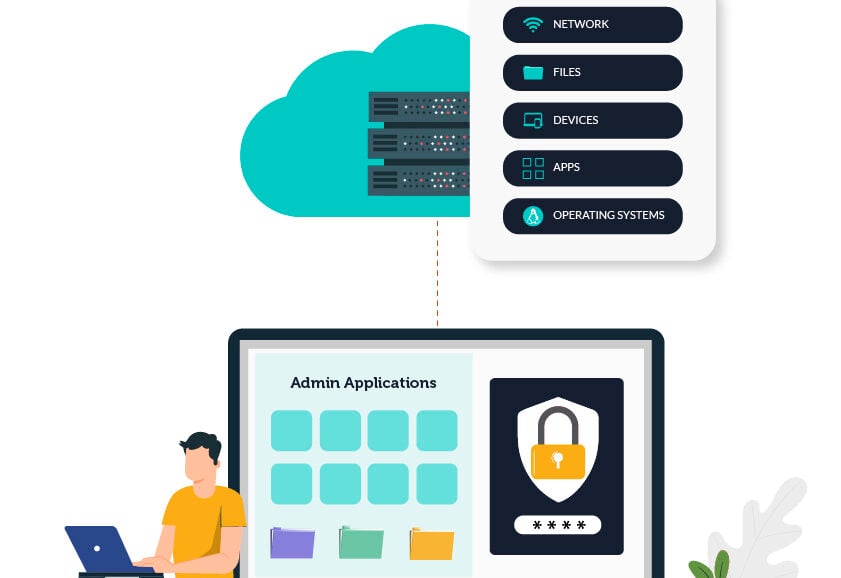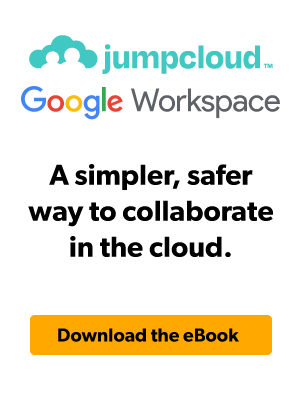Updated on December 8, 2025
There are many identity and access management (IAM) tools available, ranging from point solutions to more comprehensive solutions — i.e., platforms. Point solutions focus on very specific pieces of the IAM puzzle, rather than the big picture, like single sign-on (SSO). Platforms can be comprehensive and integrate with a vendor’s other tools, or even have significant gaps.
For example, Okta offers a strong SSO solution, but lacks unified endpoint management. That’s significant because IAM is no longer separate from device management. Consider whether you’d want a user to access confidential company information from a kid’s gaming PC. You probably wouldn’t. Taking device health/posture into account is part of Zero Trust security.
It’s understandable that making a choice for your organization can be difficult and confusing. As IT organizations dive into their research, one common question that they begin to ask is, “What’s the difference between SSO vs. Active Directory (AD)?” This article explains the differences in important factors like user productivity, security and admin efficiency.
What is Active Directory?
Microsoft Active Directory is the historical, market share leading, on-prem commercial directory service. Many IT organizations rely upon AD as their core identity provider (IdP) for authenticating resource access to Windows-based systems and applications. AD is offered as a complementary facet of Windows Server.
There are an assortment of added services available from Microsoft which, when combined, create the AD domain. The domain traditionally consists of any on-prem, Windows-based systems and applications managed through AD.
As Microsoft’s core identity and access management solution, naturally, AD works well in traditional Windows-centric networks. However, AD struggles when non-Windows or cloud-based resources come into play. A few common examples of resources that Active Directory struggles to connect and manage include Google Workspace, AWS, Salesforce, and Dropbox. Of course, the problem gets worse as IT organizations consider the use of macOS and Linux systems, Wi-Fi and VPN networks, on-prem file servers, and much more.
The Cloud Problem
The rise of the internet brought many innovations to the IT industry, one of which was the emergence of web applications. This event presented a major drawback for AD: web apps, which require identity management for proper access and security, exist outside of the traditional domain. To deal with this problem, Microsoft added another solution to the list of AD add-ons, called Active Directory Federation Services (AD FS), in 2003.
AD FS uses the SAML 2.0 protocol and WS-Federation to connect an AD identity to web applications. By doing so, AD FS widens the boundaries of the domain to include some web apps, making identity management considerably easier for IT organizations.
However, AD FS proved to be costly for admins because it’s housed on-prem and requires a server farm, making it difficult to implement. It requires a lot of additional work to maintain on top of added licensing costs. AD FS comes with hidden maintenance costs, adds unnecessary complexity to the IT landscape, and comes with security risks if used straight out of the box. Add to that the plethora of other AD solutions needed to completely manage the entire group of IT resources end users need to access, and management overhead increases dramatically.
Some organizations still use AD FS for smart card authentication, but Entra ID, Microsoft’s cloud directory offering, supports it now. Even Microsoft recognizes that AD FS can be too unwieldy. Most modern IT infrastructure is increasingly cloud-resident, or at the very least hybrid cloud.
What is Single Sign-On (SSO)?
In response to the challenges of products like AD FS, third-party vendors created more functional solutions to help extend AD identities to cloud-based and/or non-Windows resources like web applications. These vendors leveraged SAML 2.0 to extend AD identities to the cloud and created SSO tools, also known as first generation Identity-as-a-Service (IDaaS) solutions.
Coincidentally, the original web application SSO solutions hit the market at almost the exact time as AD FS. Since Microsoft has always emphasized expansion in the computing space, SSO vendors sharpened their product, giving AD’s native tool a run for its money. However, most of the competition for AD FS early on was with other on-prem, enterprise-class solutions. Over time, web application SSO solutions shifted to the cloud.
As a result, today’s SSO solutions are more refined, and they can be used as add-ons to a core directory service or as built-in functionality within a modern directory platform. The latter option eliminates the need for IT teams to manage an on-prem directory service like AD as well as a separate web app SSO solution. Some platforms have even integrated device management to take a more comprehensive approach to securing access control and identities.
Consider if you can have everything under one platform with more flexibility and functionality, why would you choose anything other than platform consolidation?
Comparing AD and SSO
Let’s examine AD and SSO side by side. AD and SSO are very different; one is an on-prem directory service — the authoritative source of identities, the other a cloud-based, web app identity extension point solution that federates the identities from a core directory to web applications.
AD FS and SSO, however, are very similar. Both solutions federate on-prem identities to cloud applications, filling a great need in modern identity management. Their core differences lie in the fact that AD FS exists on-prem while most SSO tools now live almost exclusively on the web.
Microsoft has broadened the role of AD FS on-prem with their Entra ID in the cloud. Entra ID is primarily a user management tool for identities in the Azure cloud suite, as well as Microsoft 365 (formerly Office 365). However, it’s also been extended to work with external identities for some workflows. What’s possible with Entra ID is largely driven by your subscription level.
Entra’s capabilities have grown significantly since it was introduced, but this approach still misses non-domain bound IT resources (outside of web apps) and non-Windows solutions, requiring additional AD add-ons that further embed organizations in on-prem infrastructure. Intune, another Microsoft subscription, extends management to non-Windows devices.
Microsoft’s reference architecture promotes both AD on-prem and Entra in the cloud along with connective technology called Entra ID Connect, showcasing how entrenched (both technologically and financially) an organization must remain within the Microsoft ecosystem to leverage these capabilities. Notably, several security products are required to prop up AD in order to keep identities and corporate data safe. Doing it right can become very costly.
The Big Question: Do You Need Both AD and SSO?
For admins working in modern IT environments, it’s clear that you need both a core directory and an SSO solution because each one addresses a different issue. However, there is a way to maintain a combined solution of a modern core IdP with SSO capabilities that allows users to leverage one set of credentials to access a wide variety of apps and resources.
The short answer to the question of whether you need both AD and SSO is: it depends. Some organizations would benefit from containing and modernizing AD. Others can migrate a cloud-based directory solution that seamlessly federates identities to other IT resources. For example, JumpCloud can extend AD to web apps but also federates Google and Okta identities.
JumpCloud’s Open Directory Platform provides IT organizations with the ability to manage their users, cross-OS devices, applications, networks, storage systems, network infrastructure, and more, all from the cloud. As such, this cloud directory platform gives IT admins a couple options.
Replace AD
Most organizations can migrate to a modern cloud directory, allowing them to take advantage of the cloud, efficiency, and security.
- Domain-bound Windows devices and unbound cross-OS device types
- Windows servers including Windows File Servers
- M365, Azure resources, and on-device Office installations
- Third-party Windows applications using open standards (OIDC, SAML, LDAP, etc.)
- Multiple domains, multiple forests, multiple OUs
- Multi-organization trust situations, flattening security groups and OUs
JumpCloud offers free Active Directory Integration (ADI) and Migration Utility tools to migrate identities away from AD. ADI supports multiple workflows, providing flexibility while keeping necessary services for DHCP, DNS, faxing, file sharing, printing, virtualization, and more.
Contain AD
Only enterprises with custom, homegrown applications will not be able to fully migrate. A containment strategy where these apps and AD become ring-fenced is implemented.
- Legacy and custom applications that can’t update to modern auth protocols
- Highly customized AD schema and SharePoint workflows
- Certificate-based auth for network access
- Some multi-organization forest trust situations
Sign Up for a JumpCloud Demo
If you would like to learn more about a better alternative to Active Directory, please reach out to us. Try JumpCloud for free and find out if it’s the right option for your organization’s journey away from AD.
JumpCloud’s full platform includes:
- Privilege management
- Cross-OS device management
- SSO with modern authentication policies
- Environment-wde MFA and a phishing-resistant credential
- Patch management
- Remote access and troubleshooting
- A password manager
Our customers tell us that asset management is also important for security and IT operations. JumpCloud is enhancing its platform to unify SaaS, IT security, and asset management.
Learn more about how admins will be able to consolidate security, asset, device, access, and identity management with JumpCloud and how those features go hand in hand.
Google, a JumpCloud partner, recommends the open directory platform for SMEs to modernize AD.
Frequently Asked Questions
Is LDAP the same as SSO?
No, LDAP is a protocol for accessing directory services, while SSO (Single Sign-On) is an authentication process that allows users to access multiple applications with one set of credentials.
Is Active Directory being phased out?
Active Directory (AD) is not being phased out but is evolving, especially with Microsoft’s cloud offerings like Entra ID, which aim to address modern cloud-based needs.
Does Active Directory support single sign-on?
Yes, Active Directory can support single sign-on, primarily through integrations like Active Directory Federation Services (AD FS) and with recent cloud solutions like Entra ID.
What are the main differences between SSO and Active Directory?
SSO is a cloud-based solution focused on federating identities to web applications, while Active Directory is an on-prem directory service primarily for authenticating Windows-based resources.
How does SSO work with Active Directory?
SSO can extend Active Directory’s identities to cloud-based applications, allowing users to log in once and gain access to multiple services without needing separate credentials for each.






